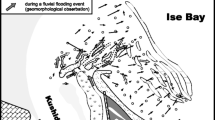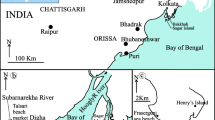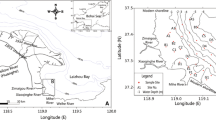Abstract
To study current marine sedimentary processes and depending on the field of application, two principal approaches exist. The first is favoured by geochemists who increasingly use GIS (Geographic Information System) methodology combined with multivariate analysis (most often Principal Component Analysis and Cluster Analysis) applied to a geochemistry dataset, to analyse the spatial distribution of the chemical elements. The interpretation of results can remain complex, and the implementation of chemical elements is limited. The second performed for sedimentary studies considers three granulometric parameters (mean, sorting and skewness) that are frequently used, which are processed by Grain Size Trend Analysis (GSTA) approach, to assess the vectors of sedimentary transport. In the current study, these two distinct approaches are combined to propose a new methodology, integrating the geochemical data into a GSTA model, to assess concentration gradients. This adapted GSTA approach, named “GSTA*”, has been tested on an existing dataset obtained from study in the eastern part of the Bay of Seine (Normandy, France) in an anthropogenic context (presence of a dumping site) to highlight the sediment dynamic processes. The results of the “classical” GSTA approach performed with granulometric parameters were compared with those from the innovative GSTA* approach, using initially one element, Total Organic Carbon (TOC), and subsequently, three combined chemical elements, Total Organic Carbon, Calcium and Silicium (TOC, Ca and Si). The suitability of geochemical tracers in the study of coastal sedimentary dynamic and anthropogenic disturbance, according to concentration gradients is highlighted. The GSTA* approach confirmed previous observations by Baux et al. [1] observations and enabled the identification of new short-scale processes and to determine sediment sources. It is a robust, non-subjective and informative methodology that can improve the interpretation of sediment sources and transport.
Graphical abstract

Similar content being viewed by others
References
Baux, N., Murat, A., Faivre, Q., Lesourd, S., Poizot, E., Méar, Y., Brasselet, S., Dauvin, J.-C.: Sediment dynamic equilibrium, a key for assessing a coastal anthropogenic disturbance using geochemical tracers: application to the eastern part of the bay of seine. Cont. Shelf Res. 175, 87–98 (2019). https://doi.org/10.1016/j.csr.2019.02.002
Hopke, P.K., Lamb, R.E., Natusch, D.F.S.: Multielemental characterization of urban roadway dust. Environ. Sci. Technol. 14, 164–172 (1980). https://doi.org/10.1021/es60162a006
Vogt, N.B., Brakstad, F., Thrane, K., Nordenson, S., Krane, J., Aamot, E., Kolset, K., Esbensen, K., Steinnes, E.: Polycyclic aromatic hydrocarbons in soil and air: statistical analysis and classification by the SIMCA method. Environ. Sci. Technol. 21, 35–44 (1987). https://doi.org/10.1021/es00155a003
Pearson, K.: On lines and planes of closet fit to systems of points in space. Lond. Edinb. Dublin Philos. Mag. J. Sci. 2, 559–572 (1901)
Hotelling, H.: Analysis of a complex of statistical variables into principal components. J. Educ. Psychol. 24, 417–441 (1933). https://doi.org/10.1037/h0071325
Syms, C.: Principal components analysis. In: Jørgensen, S.E., Fath, B.D. (eds.) Encyclopedia of Ecology, pp. 2940–2949. Academic Press, Oxford (2008). https://doi.org/10.1016/B978-008045405-4.00538-3
Lewis, P.D., Menzies, G.E.: Vibrational spectra, principal components analysis and the horseshoe effect. Vib. Spectrosc. 81, 62–67 (2015). https://doi.org/10.1016/j.vibspec.2015.10.002
Lee, C.S., Li, X., Shi, W., Cheung, S.C., Thornton, I.: Metal contamination in urban, suburban, and country park soils of Hong Kong: a study based on GIS and multivariate statistics. Sci. Total Environ. 356, 45–61 (2006). https://doi.org/10.1016/j.scitotenv.2005.03.024
Davis, H.T., Marjorie Aelion, C., McDermott, S., Lawson, A.B.: Identifying natural and anthropogenic sources of metals in urban and rural soils using GIS-based data, PCA, and spatial interpolation. Environ. Pollut. 157, 2378–2385 (2009). https://doi.org/10.1016/j.envpol.2009.03.021
Henriksson, S., Hagberg, J., Bäckström, M., Persson, I., Lindström, G.: Assessment of PCDD/fs levels in soil at a contaminated sawmill site in Sweden – a GIS and PCA approach to interpret the contamination pattern and distribution. Environ. Pollut. 180, 19–26 (2013). https://doi.org/10.1016/j.envpol.2013.05.002
Borges, R.C., Caldas, V.G., Filho, F.F.L.S., Ferreira, M.M., Lapa, C.M.F.: Use of GIS for the evaluation of heavy metal contamination in the Cunha Canal watershed and west of the Guanabara Bay, Rio de Janeiro. RJ. Mar. Pollut. Bull. 89, 75–84 (2014). https://doi.org/10.1016/j.marpolbul.2014.10.033
Velasco, V., Tubau, I., Vázquez-Suñè, E., Gogu, R., Gaitanaru, D., Alcaraz, M., Serrano-Juan, A., Fernàndez-Garcia, D., Garrido, T., Fraile, J., Sanchez-Vila, X.: GIS-based hydrogeochemical analysis tools (QUIMET). Comput. Geosci. 70, 164–180 (2014). https://doi.org/10.1016/j.cageo.2014.04.01313
El-Amier, Y.A., Elnaggar, A.A., El-Alfy, M.A.: Evaluation and mapping spatial distribution of bottom sediment heavy metal contamination in Burullus Lake. Egypt. Egypt. J. Basic Appl. Sci. 4, 55–66 (2017). https://doi.org/10.1016/j.ejbas.2016.09.005
Hou, D., O’Connor, D., Nathanail, P., Tian, L., Ma, Y.: Integrated GIS and multivariate statistical analysis for regional scale assessment of heavy metal soil contamination: a critical review. Environ. Pollut. 231, 1188–1200 (2017). https://doi.org/10.1016/j.envpol.2017.07.021
Bodrud-Doza, M., Bhuiyan, M.A.H., Islam, S.M.D.-U., Rahman, M.S., Haque, M.M., Fatema, K.J., Ahmed, N., Rakib, M.A., Rahman, M.A.: Hydrogeochemical investigation of groundwater in Dhaka City of Bangladesh using GIS and multivariate statistical techniques. Groundw. Sustain. Dev. 8, 226–244 (2019). https://doi.org/10.1016/j.gsd.2018.11.008
Facchinelli, A., Sacchi, E., Mallen, L.: Multivariate statistical and GIS-based approach to identify heavy metal sources in soils. Environ. Pollut. 114, 313–324 (2001). https://doi.org/10.1016/S0269-7491(00)00243-8
Romic, M., Romic, D.: Heavy metals distribution in agricultural topsoils in urban area. Environ. Geol. 43, 795–805 (2003). https://doi.org/10.1007/s00254-002-0694-9
Duman, M., Duman, Ş., Lyons, T.W., Avcı, M., İzdar, E., Demirkurt, E.: Geochemistry and sedimentology of shelf and upper slope sediments of the south-Central Black Sea. Mar. Geol. 227, 51–65 (2006). https://doi.org/10.1016/j.margeo.2005.11.009
Yesilonis, I.D., Pouyat, R.V., Neerchal, N.K.: Spatial distribution of metals in soils in Baltimore, Maryland: role of native parent material, proximity to major roads, housing age and screening guidelines. Environ. Pollut. 156, 723–731 (2008). https://doi.org/10.1016/j.envpol.2008.06.010
Lu, A., Wang, J., Qin, X., Wang, K., Han, P., Zhang, S.: Multivariate and geostatistical analyses of the spatial distribution and origin of heavy metals in the agricultural soils in Shunyi, Beijing. China. Sci. Total Environ. 425, 66–74 (2012). https://doi.org/10.1016/j.scitotenv.2012.03.003
Jin, Y., O’Connor, D., Ok, Y.S., Tsang, D.C.W., Liu, A., Hou, D.: Assessment of sources of heavy metals in soil and dust at children’s playgrounds in Beijing using GIS and multivariate statistical analysis. Environ. Int. 124, 320–328 (2019). https://doi.org/10.1016/j.envint.2019.01.024
Li, T., Sun, G., Yang, C., Liang, K., Ma, S., Huang, L., Luo, W.: Source apportionment and source-to-sink transport of major and trace elements in coastal sediments: combining positive matrix factorization and sediment trend analysis. Sci. Total Environ. 651, 344–356 (2019). https://doi.org/10.1016/j.scitotenv.2018.09.198
Mc Laren, P.: An interpretation of trends in grain size measures. J. Sediment. Res. 51, 611–624 (1981). https://doi.org/10.1306/212F7CF2-2B24-11D7-8648000102C1865D
Gao, S., Collins, M.B.: A critique of the. J. Sediment. Res. 61, (1991) https://archives.datapages.com/data/sepm/journals/v59-62/data/061/061001/0143.htm
Poizot, E., Mear, Y., Thomas, M., Garnaud, S.: The application of geostatistics in defining the characteristic distance for grain size trend analysis. Comput. Geosci. 32, 360–370 (2006). https://doi.org/10.1016/j.cageo.2005.06.023
Poizot, E., Méar, Y.: Using a GIS to enhance grain size trend analysis. Environ. Model. Softw. 25, 513–525 (2010). https://doi.org/10.1016/j.envsoft.2009.10.002
Pedreros, R., Howa, H.L., Michel, D.: Application of grain size trend analysis for the determination of sediment transport pathways in intertidal areas. Mar. Geol. 135, 35–49 (1996). https://doi.org/10.1016/S0025-3227(96)00042-4
Asselman, N.E.M.: Grain-size trends used to assess the effective discharge for floodplain sedimentation, river Waal, the Netherlands. J. Sediment. Res. 69, 51–61 (1999). https://doi.org/10.2110/jsr.69.51
Mallet, C., Howa, H., Garlan, T., Sottolichio, A., Le Hir, P., Michel, D.: Utilisation of numerical and statistical techniques to describe sedimentary circulation patterns in the mouth of the Gironde estuary. Comptes Rendus Académie Sci. - Ser. IIA - Earth Planet. Sci. 331, 491–497 (2000). https://doi.org/10.1016/S1251-8050(00)01437-3
Vanwesenbeeck, V., Lanckneus, J.: Residual sediment transport paths on a tidal sand Bank: a comparison between the modified McLaren model and Bedform analysis. J. Sediment. Res. 70, 470–477 (2000). https://doi.org/10.1306/2DC40920-0E47-11D7-8643000102C1865D
Friend, P.L., Velegrakis, A.F., Weatherston, P.D., Collins, M.B.: Sediment transport pathways in a dredged ria system, Southwest England. Estuar. Coast. Shelf Sci. 67, 491–502 (2006). https://doi.org/10.1016/j.ecss.2005.12.005
Kumar, P.S.R., Dwarakish, G.S., Nujuma, N., Gopinath, D.I.: Long term study of sediment dynamics along Mangalore coast. West Coast India Using Sediment Trend Analysis. Aquat. Procedia. 4, 1545–1552 (2015). https://doi.org/10.1016/j.aqpro.2015.02.200
Yamashita, S., Naruse, H., Nakajo, T.: Reconstruction of sediment-transport pathways on a modern microtidal coast by a new grain-size trend analysis method. Prog. Earth Planet. Sci. 5, 7 (2018). https://doi.org/10.1186/s40645-018-0166-9
Oliveira, A., Rocha, F., Rodrigues, A., Jouanneau, J., Dias, A., Weber, O., Gomes, C.: Clay minerals from the sedimentary cover from the northwest Iberian shelf. Prog. Oceanogr. 52, 233–247 (2002). https://doi.org/10.1016/S0079-6611(02)00008-3
Dubrulle, C., Lesueur, P., Boust, D., Dugué, O., Poupinet, N., Lafite, R.: Source discrimination of fine-grained deposits occurring on marine beaches: the Calvados beaches (eastern bay of the seine, France). Estuar. Coast. Shelf Sci. 72, 138–154 (2007). https://doi.org/10.1016/j.ecss.2006.10.021
Petrişor, A.-I., Ianoş, I., Iurea, D., Văidianu, M.-N.: Applications of principal component analysis integrated with GIS. Procedia Environ. Sci. 14, 247–256 (2012). https://doi.org/10.1016/j.proenv.2012.03.024
Jerosch, K.: Geostatistical mapping and spatial variability of surficial sediment types on the Beaufort shelf based on grain size data. J. Mar. Syst. 127, 5–13 (2013). https://doi.org/10.1016/j.jmarsys.2012.02.013
Avoine, J., Allen, G.P., Nichols, M., Salomon, J.C., Larsonneur, C.: Suspended-sediment transport in the seine estuary, France: effect of man-made modifications on estuary—shelf sedimentology. Mar. Geol. 40, 119–137 (1981)
Larsonneur, C., Auffret, J., Avoine, J.: Etudes hydrosédimentaires en Baie de Seine. (1985)
Le Hir, P., Ficht, A., Jacinto, R.S., Lesueur, P., Dupont, J.-P., Lafite, R., Brenon, I., Thouvenin, B., Cugier, P.: Fine sediment transport and accumulations at the mouth of the seine estuary (France). Estuaries. 24, 950–963 (2001)
Larsonneur, C.: Manche centrale et baie de Seine : géologie du substratum et des dépôts meubles, (1971)
Méar, Y., Poizot, E., Murat, A., Lesueur, P., Thomas, M.: Fine-grained sediment spatial distribution on the basis of a geostatistical analysis: example of the eastern bay of the seine (France). Cont. Shelf Res. 26, 2335–2351 (2006). https://doi.org/10.1016/j.csr.2006.06.009
Lesourd, S., Lesueur, P., Fisson, C., Dauvin, J.-C.: Sediment evolution in the mouth of the seine estuary (France): a long-term monitoring during the last 150years. Comptes Rendus Geosci. 348, 442–450 (2016). https://doi.org/10.1016/j.crte.2015.08.001
Brylinski, J.-M., Lagadeuc, Y., Gentilhomme, V., Dupont, J.P., Lafite, R., Dupeuble, P.-A., Huault, M.-F., Auger, Y., Puskaric, E., Wartel, M., Cabioch, L.: Le"fleuve côtier" : un phénomène hydrologique important en Manche oientale : Exemple du Pas-de-Calais. Oceanol. ACTA. SP, 197–203 (1991)
Crevel, L.: La dynamique sedimentaire en Baie de Seine nord-orientale, fluctuations et evolution de la couverture meuble. In: La Baie de Seine. Colloque National du CNRS, 24–26 avril 1985. pp. 193–200 (1985)
Méar, Y., Poizot, E., Murat, A., Beryouni, K., Baux, N., Dauvin, J.-C.: Improving the monitoring of a dumping site in a dynamic environment. Example of the Octeville site (Bay of Seine, English Channel). Mar. Pollut. Bull. 129, 425–437 (2018). https://doi.org/10.1016/j.marpolbul.2017.10.011
Brasselet, S.: Dragages d’entretien du Grand Port Maritime du Havre. Arrêté interpréfectoral du 26/10/2009 : Renouvellement de l’autorisation de dragage et de l’immersion des produits de dragages d’entretien du GPMH. Demande de renouvellement. Grand Port Maritime du Havre (GPMH) - Service Accès et Environnement Maritime (2014)
Reynolds, R.C.: Potassium-rubidium ratios aud polymorphism in illites and microclines from the clay size fractions of proterozoic carbonate rocks. Geochim. Cosmochim. Acta. 27, 1097–1112 (1963). https://doi.org/10.1016/0016-7037(63)90092-9
Matheron, G.: Les variables régionalisées et leur estimation. Masson Paris Fr. 1–305 (1965)
Renard, D., Bez, N., Desassis, N., Beucher, H., Ors, F., Freulon, X.: RGeostats: Geostatistical Package version 11.1.1. (2020)
Poizot, E., Méar, Y., Biscara, L.: Sediment trend analysis through the variation of granulometric parameters: a review of theories and applications. Earth-Sci. Rev. 86, 15–41 (2008). https://doi.org/10.1016/j.earscirev.2007.07.004
Oliver, M.A., Webster, R.: Kriging: a method of interpolation for geographical information systems. Int. J. Geogr. Inf. Syst. 4, 313–332 (1990). https://doi.org/10.1080/02693799008941549
McLaren, P., Bowles, D.: The effects of sediment transport on grain-size distributions. J. Sediment. Res. 55, 457–470 (1985). https://doi.org/10.1306/212F86FC-2B24-11D7-8648000102C1865D
Gao, S., Collins, M.B.: Net sediment transport patterns inferred from grain-size trends, based upon definition of “transport vectors.” Sediment. Geol. 81, 47–60 (1992). https://doi.org/10.1016/0037-0738(92)90055-V
Poizot, E., Méar, Y.: eCSedtrend: a new software to improve sediment trend analysis. Comput. Geosci. 34, 827–837 (2008). https://doi.org/10.1016/j.cageo.2007.05.022
Okada, T., Larcombe, P., Mason, C.: Estimating the spatial distribution of dredged material disposed of at sea using particle-size distributions and metal concentrations. Mar. Pollut. Bull. 58, 1164–1177 (2009). https://doi.org/10.1016/j.marpolbul.2009.03.023
Paatero, P., Tapper, U., Aalto, P., Kulmala, M.: Matrix factorization methods for analysing diffusion battery data. J. Aerosol Sci. 22, S273–S276 (1991). https://doi.org/10.1016/S0021-8502(05)80089-8
Song, X.-H., Polissar, A.V., Hopke, P.K.: Sources of fine particle composition in the northeastern US. Atmos. Environ. 35, 5277–5286 (2001). https://doi.org/10.1016/S1352-2310(01)00338-7
Polissar, A.V., Hopke, P.K., Harris, J.M.: Source regions for atmospheric aerosol measured at Barrow. Alaska. Environ. Sci. Technol. 35, 4214–4226 (2001). https://doi.org/10.1021/es0107529
Song, Y., Xie, S., Zhang, Y., Zeng, L., Salmon, L.G., Zheng, M.: Source apportionment of PM2.5 in Beijing using principal component analysis/absolute principal component scores and UNMIX. Sci. Total Environ. 372, 278–286 (2006). https://doi.org/10.1016/j.scitotenv.2006.08.041
Khlaifi, A.: Estimation des sources de pollution atmosphérique par modélisation inverse, (2007)
Gao, S., Collins, M.B.: Analysis of grain size trends, for defining sediment transport pathways in marine environments. J. Coast. Res. 10, 70–78 (1994)
Gao, S., Collins, M.B.: The use of grain size trends in marine sediment dynamics: a review. Chin. J. Oceanol. Limnol. 19, 265–271 (2001). https://doi.org/10.1007/BF02850664
Le Roux, J.P., Rojas, E.M.: Sediment transport patterns determined from grain size parameters: overview and state of the art. Sediment. Geol. 202, 473–488 (2007). https://doi.org/10.1016/j.sedgeo.2007.03.014
McLaren, P., Hill, S.H., Bowles, D.: Deriving transport pathways in a sediment trend analysis (STA). Sediment. Geol. 202, 489–498 (2007). https://doi.org/10.1016/j.sedgeo.2007.03.011
Méar, Y., Poizot, E., Murat, A., Beryouni, K., Baux, N., Dauvin, J.-C.: Improving the monitoring of a dumping site in a dynamic environment. Example of the Octeville site (Bay of Seine, English Channel). Mar. Pollut. Bull. (2017). https://doi.org/10.1016/j.marpolbul.2017.10.011
Acknowledgments
The authors are grateful to research RIN (“Réseaux d’Intérêts Normands”) for their funding of the SELINe project. We wish to thank to the “Grand Port Maritime du Havre” and the crews of the two ships, “Le Marais” and the “Côtes de la Manche”. We thank all the staffs for assistance in technical operations. The authors would like to express their gratitude to Dr. Colin Burton for his detailed correction of the English used in the manuscript. At least, we greatly thank the anonymous reviewer whose comments and suggestions helped to improve and clarify this manuscript.
Author information
Authors and Affiliations
Corresponding author
Additional information
Publisher’s note
Springer Nature remains neutral with regard to jurisdictional claims in published maps and institutional affiliations.
Highlights
• Aim: Adaptation of existing GSTA approach with geochemical parameters.
• Study of sedimentary processes, sources and transport.
• New methodology enabled the identification of new short-scale processes
Rights and permissions
About this article
Cite this article
Baux, N., Murat, A., Poizot, E. et al. An innovative geostatistical sediment trend analysis using geochemical data to highlight sediment sources and transport. Comput Geosci 26, 263–278 (2022). https://doi.org/10.1007/s10596-021-10123-5
Received:
Accepted:
Published:
Issue Date:
DOI: https://doi.org/10.1007/s10596-021-10123-5




